When was the last time you went through your site to make sure all the content on it is truly useful and valuable to your audience? If you're like most, it’s probably been a while. And, If you’re paying attention to what Google’s algorithm is favoring these days, that might be an issue.
Google is better than ever at understanding the content on your site and assessing the quality of any given page. As a result, it’s devaluing websites, and web pages with low quality content and elevating those with high quality content. Sure Google’s always done this, but it’s getting better than ever at separating the wheat from the chaff.
“Our site quality algorithms are aimed at helping people find "high-quality" sites by reducing the rankings of low-quality content.” — Google
If you want your pages to rank, you need to follow Google’s advice:
“We suggest focusing on ensuring you’re offering the best content you can. That’s what our algorithms seek to reward.” — Google
So how do you ensure you are offering nothing but high quality content? By doing a content cleanup exercise.
Here’s how you can make sure your content is nothing short of stellar.
1. Understand What Google & Users Want From Your Content
Start by getting to know what users, and by proxy Google, are looking for in quality content.
Key Attributes of Quality Content:
- It’s unique and covers a topic in-depth.
- Provides original analysis and insights others haven’t.
- Trustworthy while highlighting the expertise of the author and other contributors.
- Well cited and full of references and links where necessary.
- Useful, packed with helpful specifics that catalyze people to take action.
- Easy to interact with, presented professionally, and free of factual errors.
- Provides more value than other content about the same topic.
- Mobile friendly and produced with great attention to detail.
- Shareworthy, easily shareable, and worth bookmarking.
Quality Content Is Not:
- Mass produced by unnamed writers.
- Brief, shallow and relatively uninformative i.e. thin or useless.
- Hard to read, full or errors, spelling mistakes and generally sloppy.
- Untrustworthy or questionable in terms of the expertise backing the content.
- Irrelevant or unrelated to the website it’s on.
- A reproduction of other content that already exists elsewhere on the internet.
Once you know what your audience and Google expect out of your content, you can start your content cleanup.
2. Create a Spreadsheet & Two Categories for Your Content
First things first, you need a place to do your work.
Create a Google or Excel spreadsheet called Content Cleanup where you can conduct this exercise. If you are a Pathfinder SEO subscriber, just add a new tab to your SEO workbook labeled Content Cleanup.
Here is a Content Clean Up Google Sheet template you can make a copy of.
Whether you are copying the template above or the example below, you need two categories in your spreadsheet. One where you can list all your high-quality content and one where you can list your low-quality content in need of improvement.
Each category should have four columns and multiple blank rows under each header. It should look something like this:
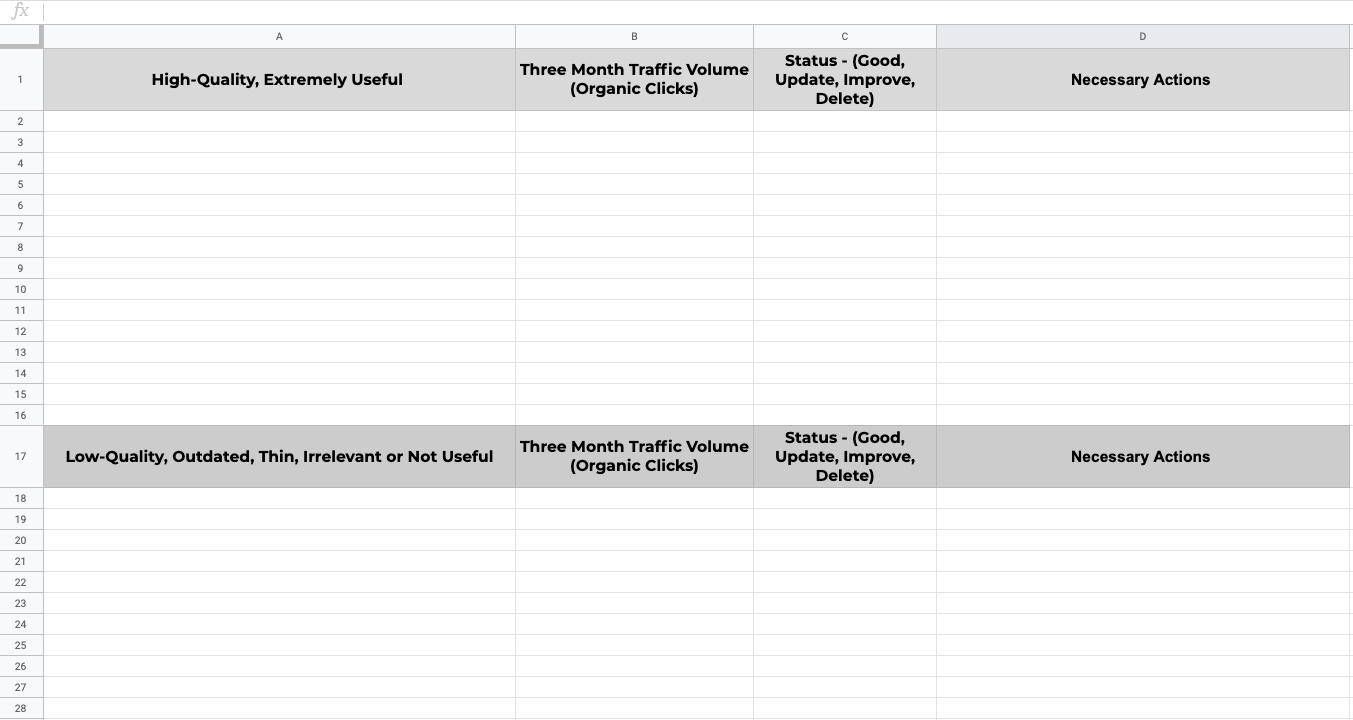
Column headers for your first category (High Quality, Extremely Useful) should read as follows:
High Quality, Extremely Useful | Three Month Traffic Volume (Organic Clicks) | Status - (Good, Update, Improve, Delete) | Necessary Actions
Column headers for your second category (Low Quality, Outdated, Thin, Irrelevant or Not Useful) should read as follows:
Low Quality, Outdated, Thin, Irrelevant or Not Useful | Three Month Traffic Volume (Organic Clicks) | Status - (Good, Update, Improve, Delete) | Necessary Actions
Now that you have a place to do your content analysis, here’s how you do it.
3. Categorize Your Content Into High-Quality & Low-Quality
Your goal is to categorize each page on your site into one of the two categories (High Quality or Low Quality) in your spreadsheet.
Here’s how to think about each category:
High Quality, Extremely Useful
This is highly useful content that is making people happy and providing ample value to your audience. It’s up to date and would likely be qualified as high quality based on the criteria above.
Low Quality, Outdated, Thin, Irrelevant or Not Useful
This is content that is lacking in one way or another. Maybe it’s not comprehensive, lacks E-A-T, is too brief i.e. thin, poorly written, or just doesn’t provide much value. The bottom line, it could be better.
Categorize Your Content
Now that you have a better idea of how to categorize your pages, start placing them in the categories where they belong.
Need a list of all your pages? Your XML sitemap is a good place to look.
If you have a large site, you can do this section by section. Maybe start with your product or service pages, then move onto your blogs, etc.
Either way, start with the ten most important pages on your site (or in a section of your site).
Be honest with your categorization! If you are on the fence about a particular piece of content, it can probably be improved and should fall into the Low-Quality category.
The end result should look something like this:
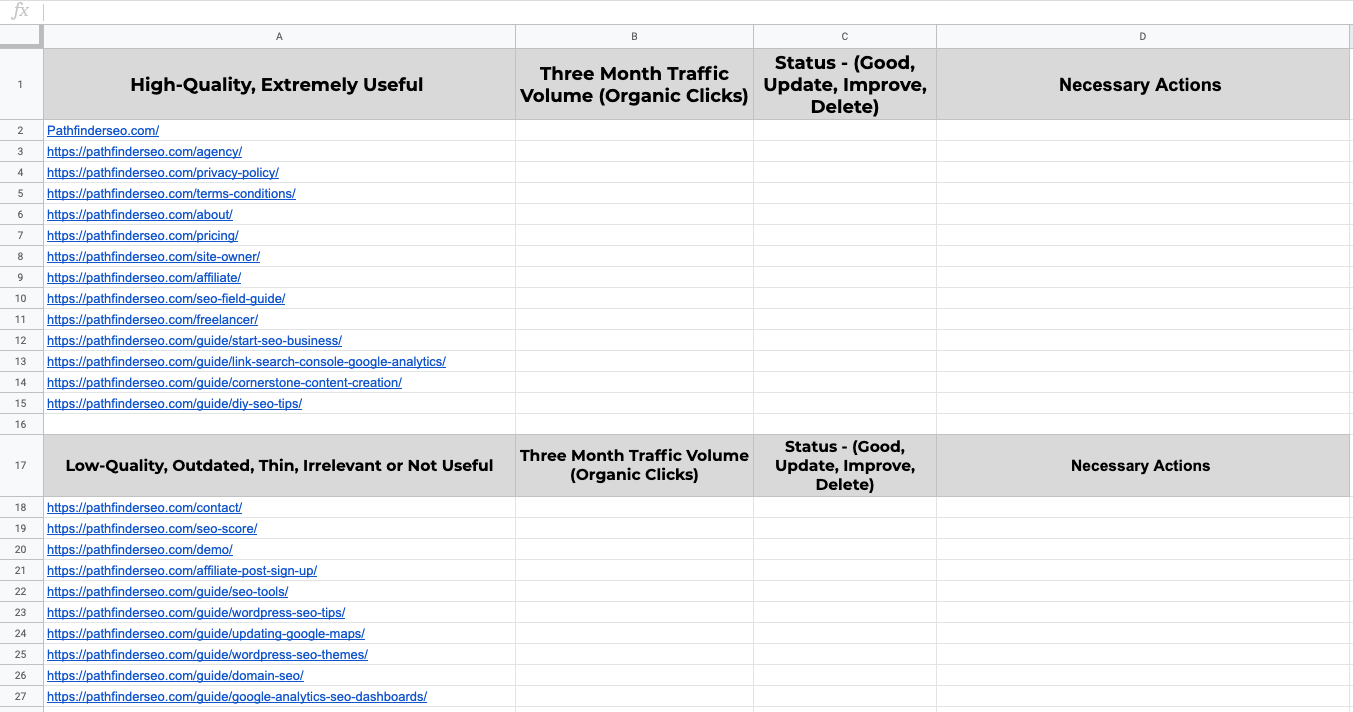
4. Quantify Organic Traffic Volume
Once you have the important pages on your site (or a section of it) sorted into the two categories, quantify how much organic traffic each page is getting.
You can confirm this by:
Going into Google Search Console > Performance (or Search Results) and setting your date range to last three months. If your business experiences lots of seasonality, you might want to set your date range to the past twelve months.
From there, click on Pages in the dimensions table and expand your Rows per page to 250 pages.
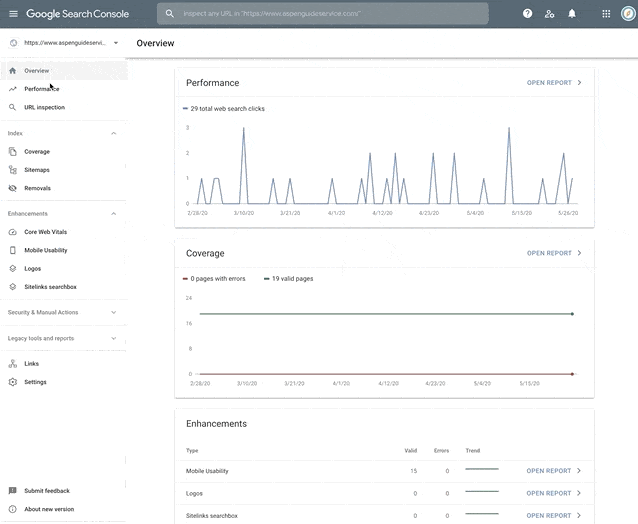
Record clicks for each page listed under the column labeled Three Month Traffic Volume in your workbook.
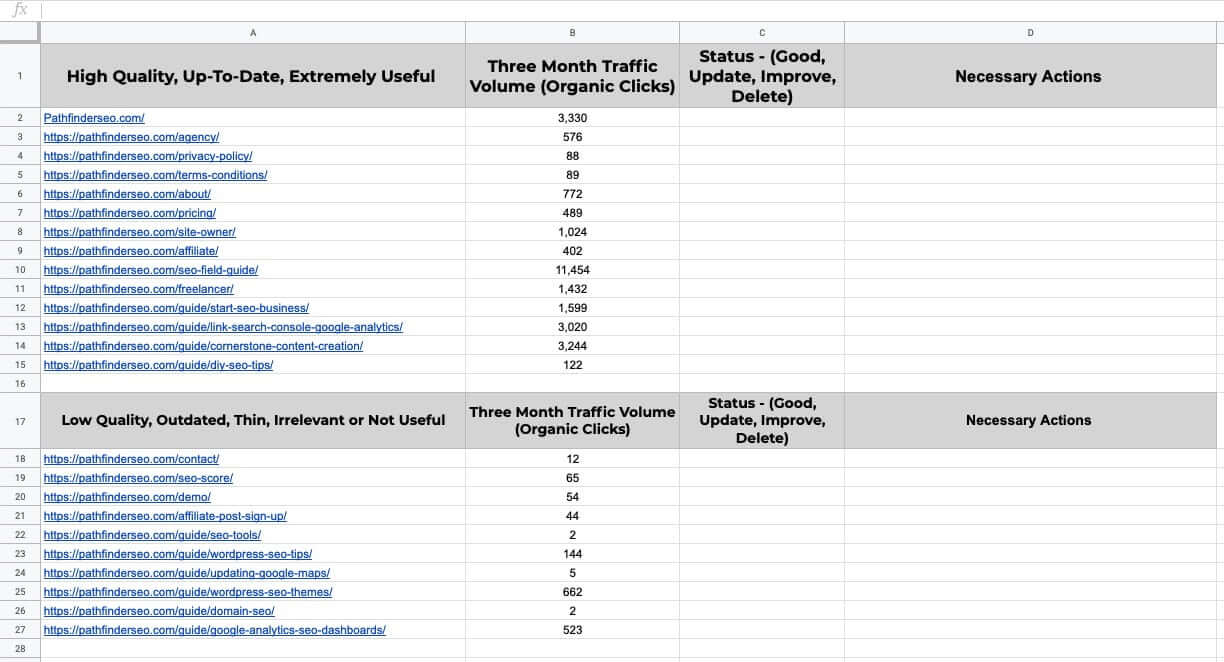
Now you have quantitative organic traffic data to help you make a more informed decision about the quality of your content.
Note: If pages on your site have large amounts of traffic from other channels than organic search, you may want to take that data into consideration. You can find out if this is the case by going into Google Analytics > Select Property > Acquisition > All Traffic > Channels.
Click on each channel to see the pages that are driving that particular type of traffic. If pages have a large amount of traffic from other channels, you may want to take note of that in your workbook and take it into account when considering what to do with a page.
5. Analyze Content & Assign a Status
Now that you know how much organic traffic each page is driving, it’s time to pair that information with a qualitative analysis of each page on your list. This will help you determine if a page is good as is or if it needs improvements or updates of some sort.
Good — A page needs no changes, is serving its purpose and driving quality organic traffic.
Update — All, or portions of, the content on a page should be updated because it is outdated.
Improve — A page is relevant and worth keeping, but content quality needs improvement.
Delete & Redirect — Page is irrelevant, not useful, outdated or not worth investing time in, i.e. low-quality.
Update & Improve statuses can, and will, often go together.
Along with each status, you will also want to identify necessary actions, if any, that you should be taking to improve the quality of your content.
Identify & Note Necessary Actions
When you assign a page an Update and/or Improve status, consider how you will make it better.
Start by looking at the pages Google is ranking for the same topic your page covers. What are those pages doing better than yours? How can you learn from those pages and create a higher quality, more useful resource for your audience?
Here are some common content improvements worth considering:
- Break your content up using headers and improve its readability.
- Expand your content to make it longer and more comprehensive.
- Provide more topically relevant expert insights gathered from around the internet.
- Integrate better keywords and phrases related to the topic you are addressing.
- See what questions people are asking about your topic using AlsoAsked.com and integrate answers into your content.
- Add useful internal and external links.
- Add high-quality imagery and descriptive alt text attributes.
- Edit it for clarity and simplicity.
- Include more relevant examples, stories, and lists.
- Bold or underline important keywords and phrases to make it easier to scan.
- If you assigned a Delete status to a page, now is also a good time to identify a good page to redirect its URL to with a 301 redirect once you delete it.
In general, you want to redirect the URL of the page you are deleting to a live page with content similar to what was on the page you are deleting. If no similar pages exist, consider redirecting to a category page relevant to the page being deleted. Avoid redirecting all deleted content to your homepage.
Don’t be afraid to include multiple necessary actions when required!
Here’s what your spreadsheet should look like as you begin to work through it.
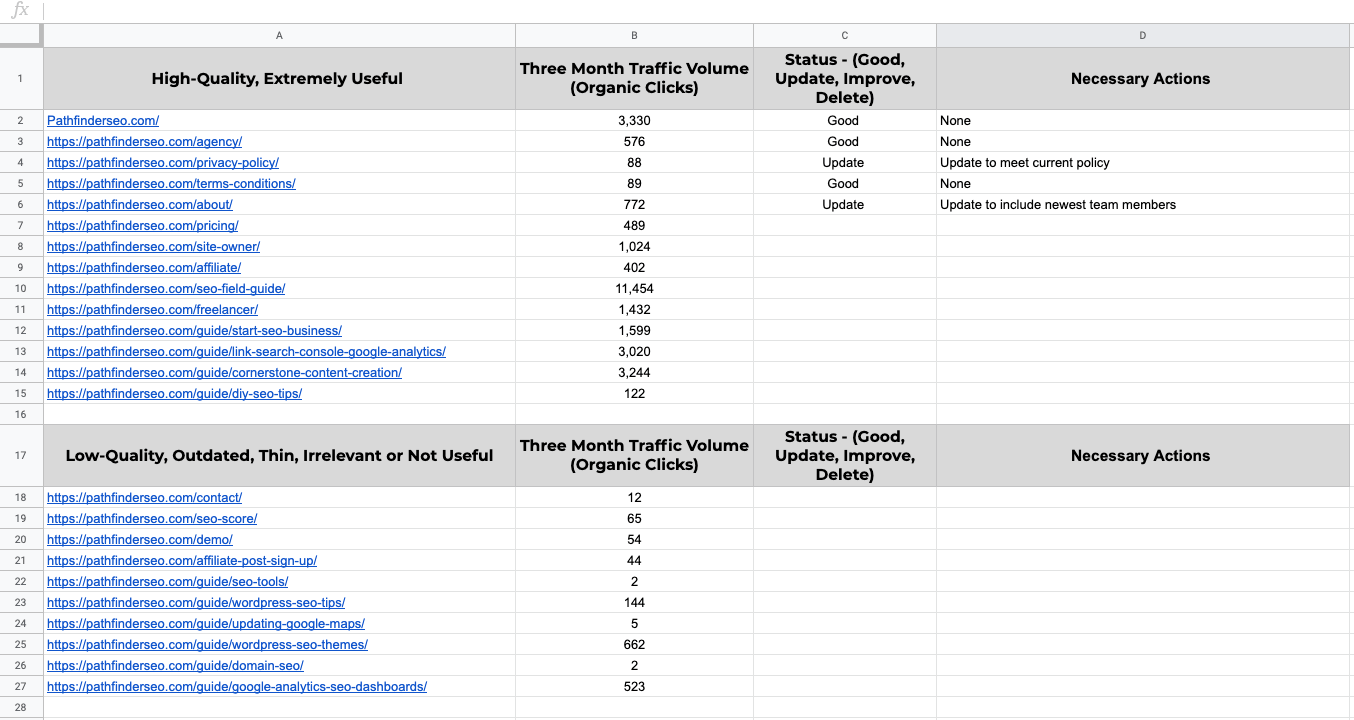
Tips for Analyzing High-Quality, Extremely Useful Pages
Pages that fall into the high quality content category may require no changes and are probably driving quality traffic already.
With that said, it’s still worth looking at each page and noting any improvements or updates that might be needed. It’s always worth making good content even better! After all, how else are you going to fend off up and comers in the rankings?
If a page isn’t getting as much organic traffic as you might like it to, that’s also a great opportunity to identify ways you can improve the content on it or its on-site optimization.
If you discover pages that aren’t actually that great during your analysis, don’t hesitate to move them to the Low-Quality category. This will help you prioritize what to do with them.
Tips for Analyzing Low-Quality, Outdated, Thin, Irrelevant, or Not Useful Pages
When it comes to content that isn’t really pulling its weight, we want you to ask one key question:
Is this content worth keeping?
Here’s how you answer that question:
If a page isn’t getting organic clicks, isn’t essential to the site, and/or isn’t providing users with much value, the answer is likely NO, it’s not worth keeping. If you can’t — or don’t want to — improve that page to make it more useful, consider deleting it and redirecting its URL to a similar page using a 301 redirect. Alternatively, you can merge it with another piece of content to create a resource that is actually valuable to users.
If a page is getting good organic clicks, is essential to your site (i.e. landing pages, contact forms, etc.), and/or providing value to your audience, the answer is probably YES, it’s worth keeping. With that being said and if it’s in the Low Quality category, it can probably be improved. What improvements will make it the most useful page imaginable?
The end product of this phase is a spreadsheet that tells you which page you need to Update, Improve, Delete and Redirect, or leave as is because they are good to go.
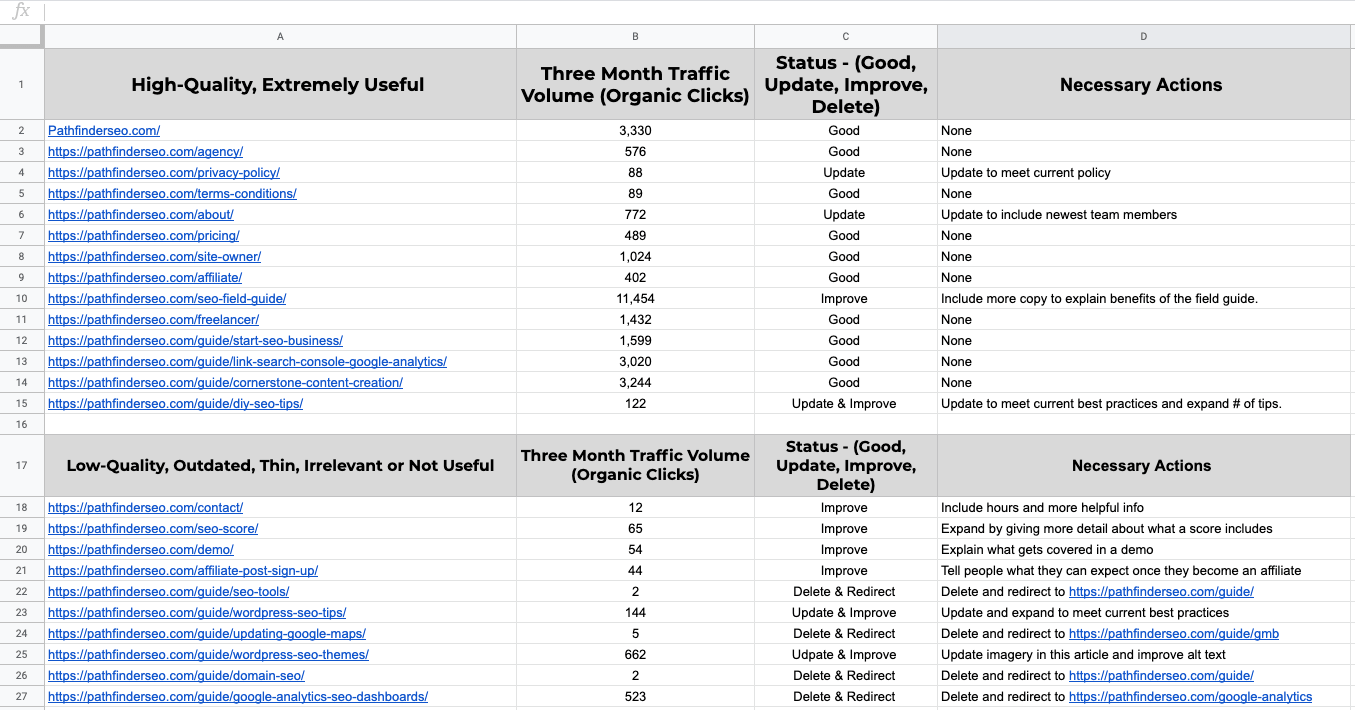
You’re almost done! Now you just have to create a plan to make all those changes.
6. Prioritize Improvements & Get To Work
Once you know what actions need to be taken to cleanup your content, start prioritizing which pages you are going to take action on first. Reorder the pages in your categories accordingly.
We like to start by deleting and redirecting low-quality content. Then we move into addressing smaller required improvements to existing content. From there we dive into bigger tasks like completely reworking or combining content.
You get to decide how you prioritize your work, but the bottom line is that you need to pull together a work plan and start taking action!
Final Thoughts
Conducting a content cleanup doesn’t have to be rocket science. You just need to follow this process:
- Understand What Google & Users Want From Your Content
- Create a Spreadsheet & Two Categories for Your Content
- Categorize Your Content Into High Quality & Low Quality
- Quantify Organic Traffic Volume
- Analyze Content & Assign a Status
- Prioritize Improvements & Get To Work
If you can fill your site with nothing but highly useful content, you will never find yourself sweating when Google rolls out fresh algorithm updates. Instead, you will have a future-proof website capable of driving qualified traffic.
If you like this process for cleaning up your content, learn how Pathfinder SEO can help you clean up your entire site using our guided approach to SEO.